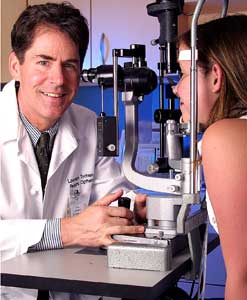 Lawerence Tychsen
Lawerence TychsenNeurologist Jan Brunstrom diagnoses a host of special needs children who have disorders ranging from autism to cerebral palsy. When she finds a patient with impaired eyesight, she refers him to Lawrence Tychsen.
Tychsen, a pediatric ophthalmologist at Washington University’s Medical School and ophthalmologist in chief at St. Louis Children’s Hospital, first started working with Brunstrom five years ago after she approached and explained her referral system to him. The special needs children she works with, ages one to young adulthood, often receive diagnoses in multiple areas, from impaired vision to skeletal development. If she suspects one of her patients needs further medical attention beyond neurological help, Brunstrom will refer the patient to a pediatric specialist.
“Children who have profound neuro-behavioral problems have great difficulty wearing glasses,” Tychsen said. “Most of the time they didn’t have glasses on, where the glasses were broken or lost, or they left them on their head. They went through life with profoundly blurred vision to the point of legal blindness.”
Special needs children have the same eye problems as otherwise healthy children, but they tend to have a higher prevalence of them. Tychsen suspected that most of the special needs children in the St. Louis area have access to treatment, but nationwide many younger patients’ problems go unaddressed. Children with special needs take up more time and energy and parents may find it difficult to concentrate on all their maladies.
“It can be very frustrating for the parents of a multi-handicapped child to deal with the vision issues because their plate is full. In that sense their vision problems tend to get neglected because many people think they aren’t as serious as the other issues the kids have,” said Tychsen.
After Brunstrom refers her patients to Tychsen, he runs a variety of tests to determine how to best treat them. Many of the special needs children are either non-verbal or quasi-verbal and are unable to cooperate through standard testing, but Tychsen can sidestep their communication deficiencies by using tests to measure their vision and focusing.
“We have a number of computerized, digital tests that measure brain activity in relation to the child looking at visual pictures,” he explained.
Cerebral palsy patients tend to have normal cognitive abilities, but their motor abilities can impede their ability to comfortably wear glasses.
Many sight-impaired children have trouble focusing on objects, a problem that is exacerbated by not wearing glasses. Tychsen described them as living “in a cocoon of visual blur where the walls of that cocoon can be only inches from their face.”
Unable to perceive their environment, friends and family clearly, these children often have a general increased fearfulness as well as blunted social interactions and decreased interest in people and objects because they cannot see, Tychsen said.
Once he diagnoses the child, Tychsen decides the best form of eye operation. His most frequent surgery, refractive, which includes a variation of Lasik, and intraocular lens implants, have a 90 percent or greater success rate, he said. Tychsen also operates on children who have wandering, crossed or wiggling eyes, which often involves eye muscle surgery.
Non-disabled patients are normally discouraged from Lasik laser eye surgery until age 21 and above as the eye continues to change shape until young adulthood. Tychsen said that he has to retreat about 10 percent of his patients as they grow older. “You deliberately plan for the growth of the eye, so you overcorrect the younger children a bit to compensate for that,” he said. His pediatric Lasik operations are done without making a flap in the cornea, the outer part of the eye, as children usually rub their eyes and could damage the healing flap.
Tychsen’s patients pay him multiple visits for check-ups in the following months and years. “Often the responses of the child are dramatic. It’s very gratifying, some of the testimonials that the parents give are very moving,” he said, explaining that children often develop substantially after their eyesight is corrected. “The child becomes much more interested in other people and in trying new things. There’s a flowering of self confidence.”